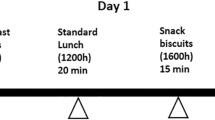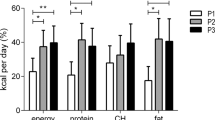Abstract
BACKGROUND/OBJECTIVES:
The aim was to investigate the effects of a conventional and an unconventional fast-food meal on postprandial metabolism in normal and in overweight subjects.
SUBJECTS/METHODS:
Twenty-five healthy normal (n=12) and overweight (n=13) volunteers (21–39 years) participated in this randomized, dietary cross-over study and received two test meals (matched in energy and energy giving nutrients) after an overnight fast with 1 week between test days. The conventional fast-food meal was a hamburger meal (hamburger, bacon, cola drink, calculated glycemic load=48.7), the unconventional fast food was a salmonburger meal (fiber-rich sourdough rye bread, salad with vinegar, orange juice, glycemic load=46.0). Blood samples were taken before and after the meal and analyzed for glucose (before 20, 40, 60 and 80 min) and insulin (before 1, 2 and 3 h).
RESULTS:
Postprandial increases in glucose and insulin were 44% lower after the unconventional meal (P<0.001 and P=0.003, respectively). The difference between meals in insulin response (that is, conventional meal higher than unconventional) correlated with body mass index (BMI) (r=0.538, P=0.006).
CONCLUSIONS:
Unconventional fast food can have less effect on blood insulin and glucose postprandially compared with conventional fast food matched in energy and energy giving nutrients. The difference between meals in insulin response is associated with higher BMI. Thus, improvement in food quality might help to control postprandial increases in blood glucose and blood insulin.
This is a preview of subscription content, access via your institution
Access options
Subscribe to this journal
Receive 12 print issues and online access
$259.00 per year
only $21.58 per issue
Buy this article
- Purchase on Springer Link
- Instant access to full article PDF
Prices may be subject to local taxes which are calculated during checkout



Similar content being viewed by others
References
Mozaffarian D, Wilson PW, Kannel WB . Beyond established and novel risk factors: lifestyle risk factors for cardiovascular disease. Circulation 2008; 117: 3031–3038.
Davis N, Katz S, Wylie-Rosett J . The effect of diet on endothelial function. Cardiol Rev 2007; 15: 62–66.
Mozaffarian D, Katan MB, Ascherio A, Stampfer MJ, Willett WC . Trans fatty acids and cardiovascular disease. N Engl J Med 2006; 354: 1601–1613.
Mozaffarian D, Micha R, Wallace S . Effects on coronary heart disease of increasing polyunsaturated fat in place of saturated fat: a systematic review and meta-analysis of randomized controlled trials. PLoS Med 2010; 7: e1000252.
Jacobs DR, Gallaher DD . Whole grain intake and cardiovascular disease: a review. Curr Atheroscler Rep 2004; 6: 415–423.
Dauchet L, Amouyel P, Hercberg S, Dallongeville J . Fruit and vegetable consumption and risk of coronary heart disease: a meta-analysis of cohort studies. J Nutr 2006; 136: 2588–2593.
Zarraga IG, Schwarz ER . Impact of dietary patterns and interventions on cardiovascular health. Circulation 2006; 114: 961–973.
Margioris AN . Fatty acids and postprandial inflammation. Curr Opin Clin Nutr Metab Care 2009; 12: 129–137.
Hansen K, Sickelmann F, Pietrowsky R, Fehm HL, Born J . Systemic immune changes following meal intake in humans. Am J Physiol 1997; 273: R548–R553.
Hotamisligil GS . Inflammation and metabolic disorders. Nature 2006; 444: 860–867.
Rahelić D, Jenkins A, Bozikov V, Pavić E, Jurić K, Fairgrieve C et al. Glycemic index in diabetes. Coll Antropol 2011; 35: 1363–1368.
Lopes da Silva MV, de Càssia Gonçalves Alfenas R . Effect of the glycemic index on lipid oxidation and body composition. Nutr Hosp 2011; 26: 48–55.
Esfahani A, Wong JM, Mirrahimi A, Villa CR, Kendall CW . The application of the glycemic index and glycemic load in weight loss: A review of the clinical evidence. IUBMB Life 2011; 63: 7–13.
Brand-Miller J, McMillan-Price J, Steinbeck K, Caterson I . Dietary glycemic index: health implications. J Am Coll Nutr 2009; 28 (Suppl), 446S–449S.
Freeland KR, Anderson GH, Wolever TM . Acute effects of dietary fibre and glycaemic carbohydrate on appetite and food intake in healthy males. Appetite 2009; 52: 58–64.
Shin Y, Park S, Choue R . Comparison of time course changes in blood glucose, insulin and lipids between high carbohydrate and high fat meals in healthy young women. Nutr Res Pract 2009; 3: 128–133.
Johnston CS, Steplewska I, Long CA, Harris LN, Ryals RH . Examination of the antiglycemic properties of vinegar in healthy adults. Ann Nutr Metab 2010; 56: 74–79.
Samra RA, Anderson GH . Insoluble cereal fiber reduces appetite and short-term food intake and glycemic response to food consumed 75 min later by healthy men. Am J Clin Nutr 2007; 86: 972–979.
Knuth ND, Shrivastava CR, Horowitz JF . Reducing dietary fat from a meal increases the bioavailability of exogenous carbohydrate without altering plasma glucose concentration. J Appl Physiol 2009; 106: 122–129.
Spencer EH, Frank E, McIntosh NF . Potential effects of the next 100 billion hamburgers sold by McDonald’s. Am J Prev Med 2005; 28: 379–381.
Rosenheck R . Fast food consumption and increased caloric intake: a systematic review of a trajectory towards weight gain and obesity risk. Obes Rev 2008; 9: 535–547.
Atkinson FS, Foster-Powell K, Brand-Miller JC . International tables of glycemic index and glycemic load values. Diabetes Care 2008; 31: 2281–2283.
The University of Sydney. Glycemic Index Database. http://www.glycemicindex.com/index.php . Last update: 1 December 2011.
National Cancer Institute. Risk Factor Monitoring and Methods. Glycemic Index Values Database. http://riskfactor.cancer.gov/tools/glycemic/ . Last update: 17 February 2009.
Carbohydrates in human nutrition. FAO Food and Nutrition Paper-66. Available online under http://www.fao.org/docrep/W8079E/w8079e0a.htm . Accessed 1 May 2011.
Rudolph TK, Ruempler K, Schwedhelm E, Tan-Andresen J, Riederer U, Rainer H et al. Acute effects of various fast-food meals on vascular function and cardiovascular disease risk markers: the Hamburg Burger Trial. Am J Clin Nutr 2007; 86: 334–340.
Bray GA, Most M, Rood J, Redmann S, Smith SR . Hormonal responses to a fast-food meal compared with nutritionally comparable meals of different composition. Ann Nutr Metab 2007; 51: 163–171.
Johnston CS, Buller AJ . Vinegar and peanut products as complementary foods to reduce postprandial glycemia. J Am Diet Assoc 2005; 105: 1939–1942.
Ostman E, Granfeldt Y, Persson L, Björck I . Vinegar supplementation lowers glucose and insulin responses and increases satiety after a bread meal in healthy subjects. Eur J Clin Nutr 2005; 59: 983–988.
Johnston CS, Steplewska I, Long CA, Harris LN, Ryals RH . Examination of the antiglycemic properties of vinegar in healthy adults. Ann Nutr Metab 2010; 56: 74–79.
Rizkalla SW, Laromiguiere M, Champ M, Bruzzo F, Boillot J, Slama G . Effect of baking process on postprandial metabolic consequences: randomized trials in normal and type 2 diabetic subjects. Eur J Clin Nutr 2007; 61: 175–183.
Liljeberg HG, Björck IM . Delayed gastric emptying rate as a potential mechanism for lowered glycemia after eating sourdough bread: studies in humans and rats using test products with added organic acids or an organic salt. Am J Clin Nutr 1996; 64: 886–893.
Björck I, Elmståhl HL . The glycaemic index: importance of dietary fibre and other food properties. Proc Nutr Soc 2003; 62: 201–206.
Juntunen KS, Laaksonen DE, Autio K, Niskanen LK, Holst JJ, Savolainen KE et al. Structural differences between rye and wheat breads but not total fiber content may explain the lower postprandial insulin response to rye bread. Am J Clin Nutr 2003; 78: 957–964.
Ramel A, Martinéz A, Kiely M, Morais G, Bandarra NM, Thorsdottir I . Beneficial effects of long-chain n-3 fatty acids included in an energy-restricted diet on insulin resistance in overweight and obese European young adults. Diabetologia 2008; 51: 1261–1268.
Burdge GC, Powell J, Calder PC . Lack of effect of meal fatty acid composition on postprandial lipid, glucose and insulin responses in men and women aged 50-65 years consuming their habitual diets. Br J Nutr 2006; 96: 489–500.
López S, Bermúdez B, Pacheco YM, Villar J, Abia R, Muriana FJ . Distinctive postprandial modulation of β cell function and insulin sensitivity by dietary fats: monounsaturated compared with saturated fatty acids. Am J Clin Nutr 2008; 88: 638–644.
Armah CK, Jackson KG, Doman I, James L, Cheghani F, Minihane AM . Fish oil fatty acids improve postprandial vascular reactivity in healthy men. Clin Sci (Lond) 2008; 114: 679–686.
Chong MF, Lockyer S, Saunders CJ, Lovegrove JA . Long chain n-3 PUFA-rich meal reduced postprandial measures of arterial stiffness. Clin Nutr 2010; 29: 678–681.
Vogel RA, Corretti MC, Plotnick GD . The postprandial effect of components of the Mediterranean diet on endothelial function. J Am Coll Cardiol 2000; 36: 1455–1460.
Flint A, Møller BK, Raben A, Pedersen D, Tetens I, Holst JJ et al. The use of glycaemic index tables to predict glycaemic index of composite breakfast meals. Br J Nutr 2004; 91: 979–989.
Hollenbeck CB, Coulston AM . The clinical utility of the glycemic index and its application to mixed meals. Can J Physiol Pharmacol 1991; 69: 100–107 (Review).
Pi-Sunyer FX . Glycemic index and disease. Am J Clin Nutr 2002; 76: 290S–298S (Review).
Wolever TM, Vorster HH, Björck I, Brand-Miller J, Brighenti F, Mann JI, Ramdath DD, Granfeldt Y, Holt S, Perry TL, Venter C, Wu Xiaomei . Determination of the glycaemic index of foods: interlaboratory study. Eur J Clin Nutr 2003; 57: 475–482.
Blackburn P, Lamarche B, Couillard C, Pascot A, Tremblay A, Bergeron J et al. Contribution of visceral adiposity to the exaggerated postprandial lipemia of men with impaired glucose tolerance. Diabetes Care 2003; 26: 3303–3309.
Acknowledgements
This study was part of the project Nordic YoungHealth: Possibilities and Barriers for new, healthy concepts in the fast food sector, which was managed by Kjersti Lillebø and funded by the Nordic Innovation Centre.
Author information
Authors and Affiliations
Corresponding author
Ethics declarations
Competing interests
The authors declare no conflict of interest.
Rights and permissions
About this article
Cite this article
Ramel, A., Gudmundsdottir, F. & Thorsdottir, I. Effects of two different types of fast food on postprandial metabolism in normal and overweight subjects. Eur J Clin Nutr 66, 1193–1198 (2012). https://doi.org/10.1038/ejcn.2012.125
Received:
Revised:
Accepted:
Published:
Issue Date:
DOI: https://doi.org/10.1038/ejcn.2012.125



